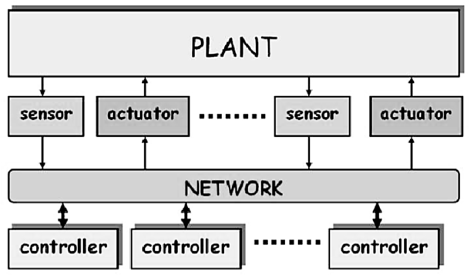Introduction and Problem Statement 1
Networked control systems (NCS) are feedback control systems wherein the control loops are closed over a shared network. Control and feedback signals are transmitted among the system’s components as information flows through a network, as depicted in figure I.1. A fully featured NCS is made up of four kinds of components to close the control loops: sensors to collect information on the controlled plant’s state, controllers to provide decisions and commands, actuators to apply the control signals and communication networks to enable communications between the NCS components.
Figure I.1. Typical NCS architecture

Compared with conventional point-to-point control systems, the advantages of NCS are lighter wiring, lower installation costs, and greater abilities in diagnosis, reconfigurability and maintenance. Furthermore, the technologies used in computer and industrial networks, both wired and wireless, have progressed rapidly providing high bandwidth, quality of service (QoS) guarantees and low communication costs. Because of these distinctive benefits, typical application of these systems nowadays ranges over various fields of industry and services. X-by-wire automotive systems, coordinated control of swarms of mobile robotics and advanced aircraft on-board control and housekeeping are examples of NCS usage in the field of embedded systems. Large-scale ...
Get Co-design Approaches to Dependable Networked Control Systems now with the O’Reilly learning platform.
O’Reilly members experience books, live events, courses curated by job role, and more from O’Reilly and nearly 200 top publishers.

